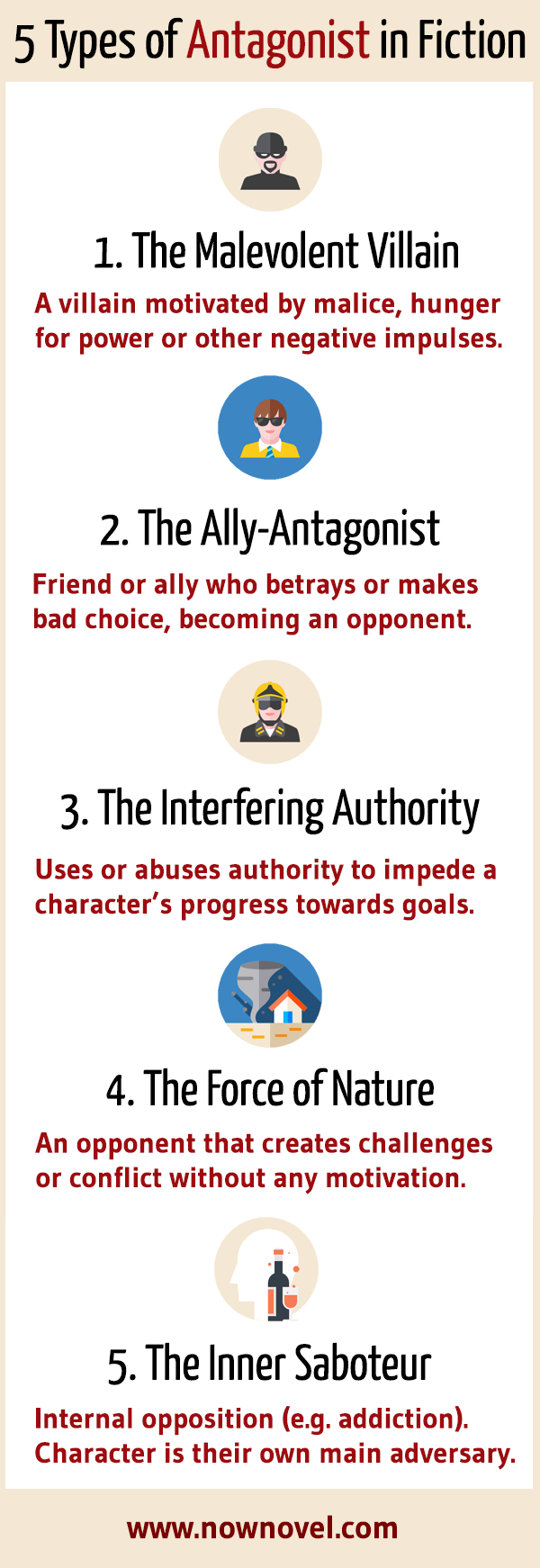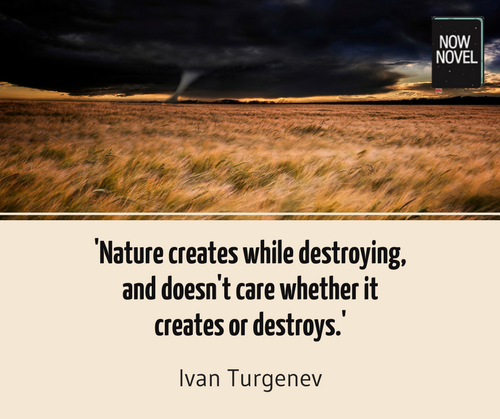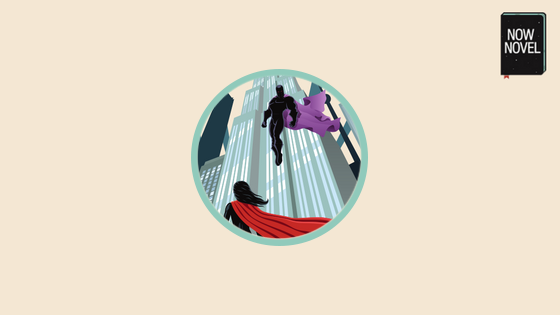There are many types of antagonists. Sometimes in a story a primary antagonist starts out as a close ally. Characters who oppose your main character’s goals aren’t necessarily ‘bad’, yet they serve a primary function: Standing between another character and their destiny. Here are 5 types of antagonists with examples and points to remember:
1. The malevolent villain
The standard malevolent villain is particularly common in the fantasy genre, yet they appear in diverse stories. The character Iago from Shakespeare’s tragedy Othello is a classic example. Iago stokes his military superior Othello’s jealousy until Othello murders his wife, suspecting her of infidelity thanks to Iago’s lies and manipulations.
Writing a malevolent antagonist character who has an appetite for destruction has pitfalls. A villain who does bad for ‘evil’s sake’ could lack development and motivations that make characters believable. You need to show their internal conflict as well, in some cases, to make them believable. The villain archetype serves as the main character’s main source of conflict. A compelling antagonist is part of what drives the plot forward, usually in opposition to the central figure of the story.
To create a believable type of villain antagonist:
- Brainstorm reasons for their actions. Sauron in Tolkien’s Lord of the Rings cycle, for example, has lost physical form and craves restored power
- Explain the origin of their corruption. Tolkien shows Sauron’s rise and fall in a prologue. Over the course of her Harry Potter series (particularly the second book), J.K. Rowling shows Lord Voldemort’s descent from being Tom Riddle to the most notorious and feared member of the wizard community
- Give them vulnerabilities or weaknesses. These don’t have to be emotional or physical. They could be strategic. For example, a villain who surrounds themselves with greedy henchmen is more vulnerable to betrayal if their supporters are easily swayed by material rewards. villain could also be up against a natural disaster or inanimate forces which weakens them.
The next type of antagonist is often surprising, as we don’t typically expect strong opposition from allies or friends:
2. The ally-antagonist
It’s particularly surprising in a story when an ally turns antagonist.
For example, in the first volume of Tolkien’s fantasy cycle, The Fellowship of the Ring, the warrior Boromir joins the main characters’ quest to destroy the One Ring. Yet Boromir disagrees with destroying it, arguing with his companions that they could use its mystical power to defeat the villain Sauron, or restore the city of Gondor. When Boromir tries to take the ring from Frodo by force, its a shocking moment where a morally complex character crosses the line from ally to antagonist.
The ally-antagonist is a useful character because they show how easy it is for a ‘good’ character to make a regrettable choice. In the wider context of Tolkien’s story, it reinforces the idea that doing good is a conscious choice and not always an easy one. It also adds secondary conflicts that illustrate the ring’s corrupting power and danger.
When writing an ally-antagonist, remember to:
- Show the flaws in their personality that explain their behaviour. Boromir is headstrong and, as a warrior, used to fighting for his ideals and using force
- Give them compelling motivations for their choices. Boromir thinks the ring’s dark power could be harnessed for good
Ally-antagonists add shades of grey in the ‘black and white’ of ‘good vs evil’. They show us how easily people can take destructive paths that result in negative outcomes. Some also refer to this type of antagonist as a ‘hero antagonist’ since they may be motivated by noble ideals. Boromir’s desire to uplift his city fits this description. The nobility or virtue of this underlying wish makes his actions more tragic, since it appears his intentions are good.

3. The interfering authority figure
The function of an antagonist, in terms of plot, is to stand between a primary character and their main goals.
An interfering authority figure is thus useful for creating challenges and complications that make life harder for your protagonist.
Depending on the interfering authority figure you create, their broader story role could be:
- To show something about the nature of power and authority in your book’s society (for example, how little power people have faced with totalitarian leadership)
- To show cultural values or practices that stand between your character and their goals (for example, traditionalist parents who oppose a ‘love match’ marriage in romance)
A good example of this type of antagonist is Allie’s mother in Nicholas Sparks’ romance novel The Notebook. Allie is from a wealthy family and her love interest Noah works as a labourer. Because of her class-conscious and controlling nature, Allie’s mother hides love letters from Noah to Allie.
This plot point shows how the interfering authority antagonist can make selfish or value-driven choices that get in your protagonist’s way.
Another example of an interfering authority antagonist would be a border patrol officer who delays characters. Perhaps they are a power-drunk bureaucrat and intentionally delay your protagonists just because they can. This would be a useful secondary antagonist if your characters’ primary goal at this moment is making it to a meeting or other event on time. orrupt politician is another villain you could introduce here. All the King’s Men, by Robert Penn Warren is an example of this. The novel tells the story of charismatic populist governor Willie Stark and his political machinations in the Depression-era Deep South.
When writing this type of antagonist, ask:
- What is their reason for interfering? In Allie’s mother’s case, it’s a controlling nature coupled with class snobbery
- How will this character’s actions impact your protagonist and create complications in the way of their goal (e.g. being with their lover or making a vital meeting on time)?

4. The force of nature
One of the few types of antagonists that don’t need a clear motivation is the ‘force of nature’.
If you think of disaster novels and films, it’s the unpredictable shark that attacks in Jaws. Some call this antagonist type the ‘beast’, but it doesn’t have to be a living or sentient being. In a survival story, this antagonist could be something with as little intent or motive as a treacherous mountain range your character climbs.
This type of antagonist does not have a character arc, in the sense of (for example) a backstory explaining how they became corrupt. Yet you can still include change and vary this type of antagonist to create tension and unpredictability.
To create an interesting and gripping ‘irrational force of destruction’:
- Make it unpredictable. For example, on a tough mountain ascent, where your antagonist is the environment itself, perhaps clouds roll in obstructing vision and making the going tougher
- Vary the intensity of opposition. On a tricky mountain ascent, create the occasional surprise rockfall or relief-bringing plateau
- Make the danger real. A shark or other antagonist is only fearful and tension-inducing if you show the repercussions of not overcoming them. Maybe someone falls; maybe someone has their leg bitten off
Although not entirely an antagonist in the sense of a separate opponent, a character’s ‘worse self’ is also a useful source of tension and opposition:
5. The inner saboteur
In a story where a character’s main struggle is an internal struggle (e.g. drug addiction), the protagonist and antagonist are rolled into one, in a sense. Rather than the main conflict being external, the conflict takes place within a single character.
The danger of this type of antagonistic situation is that your character’s thoughts could dominate the narration, without as much exchange with others. If your character’s main opponent is their own self, remember to:
- Show destructive behaviour in action. Instead of having an addict constantly think about their addiction, show how they fight it and sometimes fail. Perhaps they might visit a street hoping to score a fix but end up empty-handed, for example
- Think about the origins of their self-destructive choices. What motivated your character originally to embark on a path of self-destruction?
- Include secondary antagonists who add external conflict to the mix. An addict character, for example, may have uncomfortable brushes with law enforcement or a dangerous dealer
Examples of these include Junkie by William Burroughs, which some consider a thinly-veiled memoir of Burroughs’ addiction. Meanwhile The Man with the Golden Arm is a novel by Nelson Algren deals with the life of illicit card dealer “Frankie Machine”, who fights a growing addiction to morphine.
Examples of these include Junkie by William Burroughs, which some consider a thinly-veiled memoir of Burroughs’ addiction. Meanwhile The Man with the Golden Arm, a novel by Nelson Algren, deals with the life of illicit card dealer “Frankie Machine”, who fights a growing addiction to morphine.
There are many types of antagonist that bring gripping conflict and opposition to a story. Whichever type you create, make sure you realize each opponent with as much detail and thought as you would a protagonist.
Need help creating believable characters? Get How to Write Real Characters and work through the exercises.


13 replies on “Types of antagonists: Creating riveting opponents”
I love character driven plots so naturally, my favorite types of antagonists are the Ally and the Inner Sabateur. We all have to fight our inner demons and no matter how “good” we try to be, at one point or another, we will play antagonists in someone else’s life story…and I find that fascinating.
That’s an interesting perspective, and true about most people being an antagonist to someone else at some point in their life. Thank you for reading and sharing your thoughts!
And the funny thing is, we never know how many people’s lives we affect. We could think we’re the good guys when in reality we’re actually the bad guys. Or vice versa!
Interesting idea, Renea. There’s a great poem by Yevtushenko on this subject called ‘People were Laughing Behind a Wall’ (about not always being aware how your actions could be affecting others). It’s a beautiful one if you can find it.
Oh my god! You were so right. That was a beautiful poem and so true in its meaning. I had never heard it until now. Thank you for sharing it with me!
It’s a pleasure, Renea 🙂
Exactly! Quick story: I went into business with a friend a few years ago. Since his wife wasn’t really doing anything, he asked her to work with me to get things going fast. I thought that was a great idea.
Well, from day one, it seemed she found every possible way to sabotage every effort I made. I thought it was all in my head. After a year of hell, I was exhausted from fighting her at every step and decided for the sake of my hair and sanity, I needed to walk away. That’s when I learned the full truth.
Turns out, she pitched him a business idea he rejected in order to invest in mine. It never occurred to me that I was literally, responsible for killing her dream of starting an online chewing gum shop…(how could he pass up on that, right?).
Now I laugh at how clueless I was about her anger towards me. Even though she was benefiting from the business, she preferred to see it go down in a blazing fire of hurt, confusion and financial loss than to see me happy and successful. Love it!
Thank you for sharing that – it could make a good story in its own right. So often this type of tension and conflict comes from lack of communication in a situation where one party is hurt and not saying so directly.
Yeah, she was wrong, but as an outsider I can see her point. It must have hurt for him to choose another business opportunity so soon after rejecting hers (no matter silly it might have been). So, I give him a bit of the blame here, too. He never should have put either of you in that position with you not at least knowing the deal. So sorry this happened to you.
But that’s exactly what I thought was so interesting…(once I was able to take all the emotions out of it) like a good novel, turns out the true antagonist was the person who seemed the least culpable…her husband. When it all came down, I found out he only wanted her there so that she would report everything that I was doing – thinking this would protect his investment somehow. But she didn’t want to be there and it only made her resentful. In the end, we all lost.
Antags are, perhaps, even more important than protags to story development.
Antags are important! The right one needs to be in the story for that particular hero.
Thank you for sharing your perspective, Traci 🙂